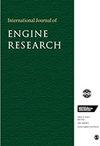SCR + ASC systems control by backward induction with adaptive grid and different disturbance scenarios
IF 2.1
4区 工程技术
Q2 ENGINEERING, MECHANICAL
引用次数: 0
Abstract
The purpose of this study is to enhance control strategies for selective catalytic reduction (SCR) and ammonia slip catalyst (ASC) systems, aiming to effectively reduce NOx emissions from automotive engines during realistic driving cycles. Despite the effectiveness of these after-treatment systems (ATS), their dynamic and non-linear characteristics present significant challenges in achieving precise control. Therefore, this research proposes a hybrid approach that combines backward induction (BI) as the primary optimization technique with model predictive control (MPC) framework for real-time application. The article introduces a reduced-state control-oriented model of the SCR + ASC system, which is embedded into the BI algorithm to calculate optimal control actions within a finite horizon. Additionally, it is proposed an alternative approach for adapting the grid of model states within the BI algorithm, effectively reducing the computational cost. This adjustment enables the algorithm to operate in real-time with near-optimal results, as confirmed by experimental validation. Lastly, the study explores how different degrees of knowledge regarding system disturbances impact the strategy’s performance, examining three distinct scenarios: constant prediction horizon, probabilistic description, and full knowledge of the prediction horizon.通过自适应电网和不同干扰情况下的后向感应控制 SCR + ASC 系统
本研究旨在加强选择性催化还原(SCR)和氨滑移催化剂(ASC)系统的控制策略,以有效减少汽车发动机在实际驾驶循环中的氮氧化物排放。尽管这些后处理系统(ATS)效果显著,但其动态和非线性特性给实现精确控制带来了巨大挑战。因此,本研究提出了一种混合方法,将作为主要优化技术的后向感应(BI)与实时应用的模型预测控制(MPC)框架相结合。文章介绍了 SCR + ASC 系统的简化状态控制导向模型,并将其嵌入 BI 算法,以计算有限范围内的最优控制操作。此外,文章还提出了一种在 BI 算法中调整模型状态网格的替代方法,从而有效降低了计算成本。实验验证证实,这种调整可使算法以接近最优的结果实时运行。最后,该研究探讨了不同程度的系统干扰知识对该策略性能的影响,研究了三种不同的情况:恒定预测范围、概率描述和预测范围的完全知识。
本文章由计算机程序翻译,如有差异,请以英文原文为准。
求助全文
约1分钟内获得全文
求助全文
来源期刊

International Journal of Engine Research
工程技术-工程:机械
CiteScore
6.50
自引率
16.00%
发文量
130
审稿时长
>12 weeks
期刊介绍:
The International Journal of Engine Research publishes high quality papers on experimental and analytical studies of engine technology.
 求助内容:
求助内容: 应助结果提醒方式:
应助结果提醒方式:


